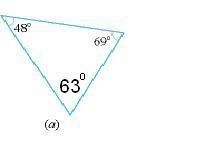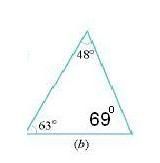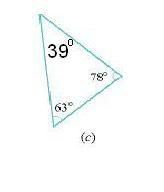SOLUTION: 5. Which two triangles are similar?
<a href="http://s293.photobucket.com/albums/mm56/cool_user2004/?action=view¤t=5.jpg" target="_blank"><img src="http://i293.photobuc
Algebra.Com
Question 139950: 5. Which two triangles are similar?

Answer by jim_thompson5910(35256) (Show Source): You can put this solution on YOUR website!
First, we need to find the missing angles of each triangle.
For the first triangle, first add up the two given angles 69 and 48 to get
Now subtract 117 from 180 to get
So the first triangle has these angles

---------------------------------------------------------
For the second triangle, first add up the two given angles 63 and 48 to get
Now subtract 111 from 180 to get
So the second triangle has these angles

------------------------------------------------------------
For the third triangle, first add up the two given angles 63 and 48 to get
Now subtract 111 from 180 to get
So the third triangle has these angles

----------------------------------------------------------
Summary:
So the three triangles have these angles

----------------------------------------------------------
Answer:
Remember, similar triangles have equal angles. From the figure, we can see that triangles a) and b) have equal angles. So triangles a) and b) are similar triangles.
RELATED QUESTIONS
4. The two triangles are similar. Find the indicated side. Find y.
(answered by jim_thompson5910)
Find the missing length of the right triangle
(answered by jim_thompson5910)
6. Find the missing angle.
(answered by jim_thompson5910)
3. Identify the hypotenuse of the triangle by giving its letter
(answered by jim_thompson5910)
7. Find the measure of angle x and measure of angle y.
(answered by jim_thompson5910)
We are learning Similar Triangles by AA, SSS and SAS.
I am not sure how to fine the... (answered by richard1234)
How do I find the Measure of arc BC?
(answered by Edwin McCravy)
Please help me with this proof:
(answered by jim_thompson5910)
Please help me solve this proof.
(answered by richwmiller)





